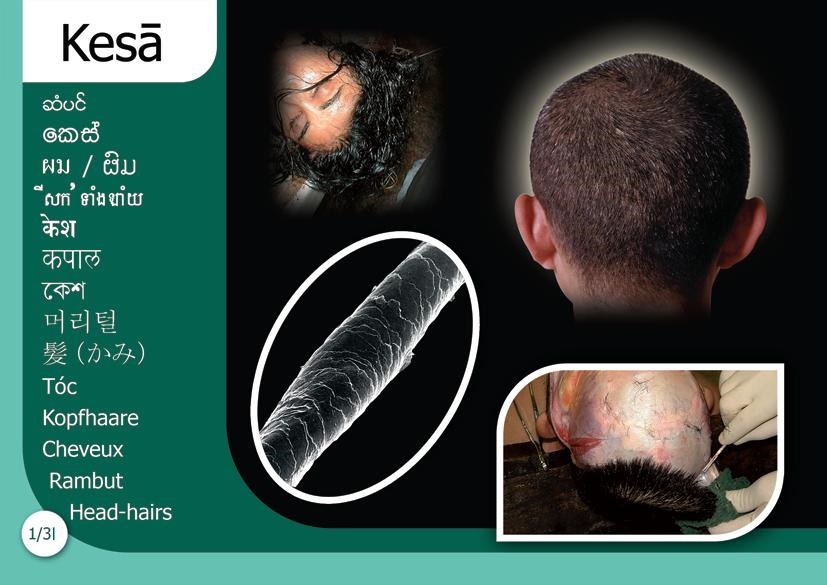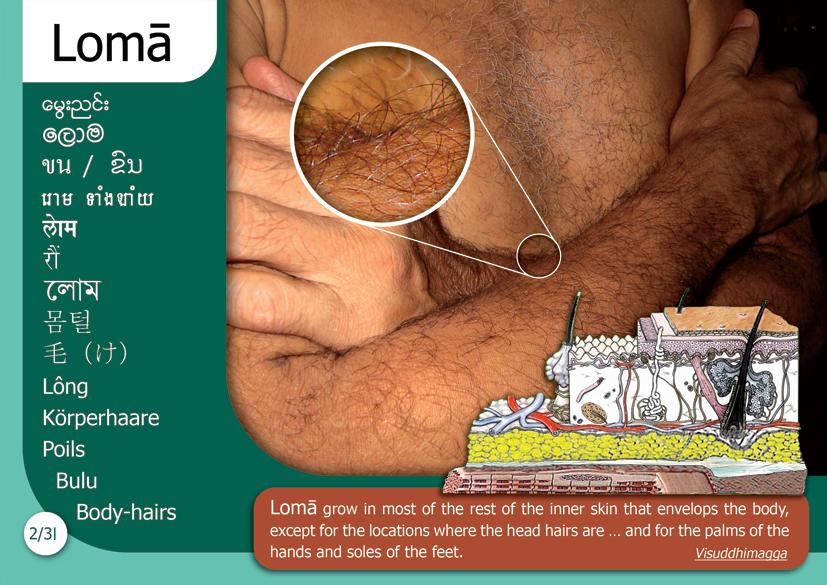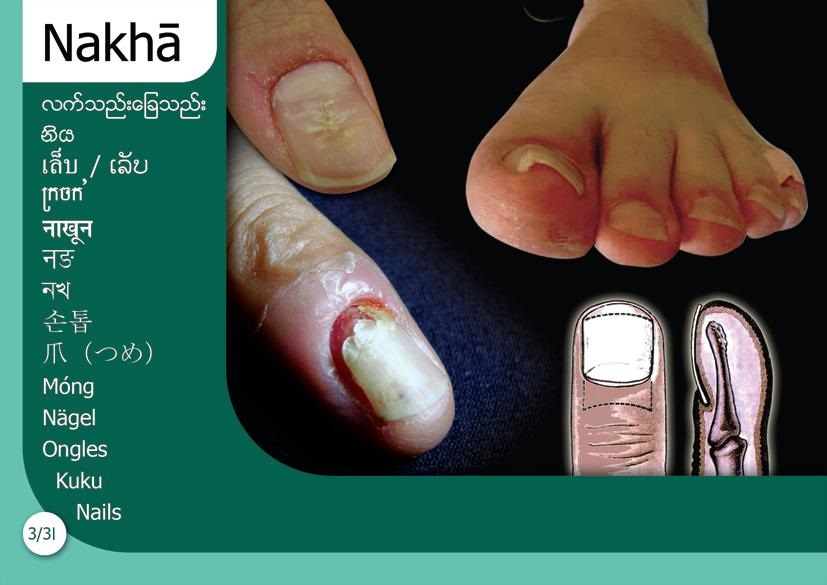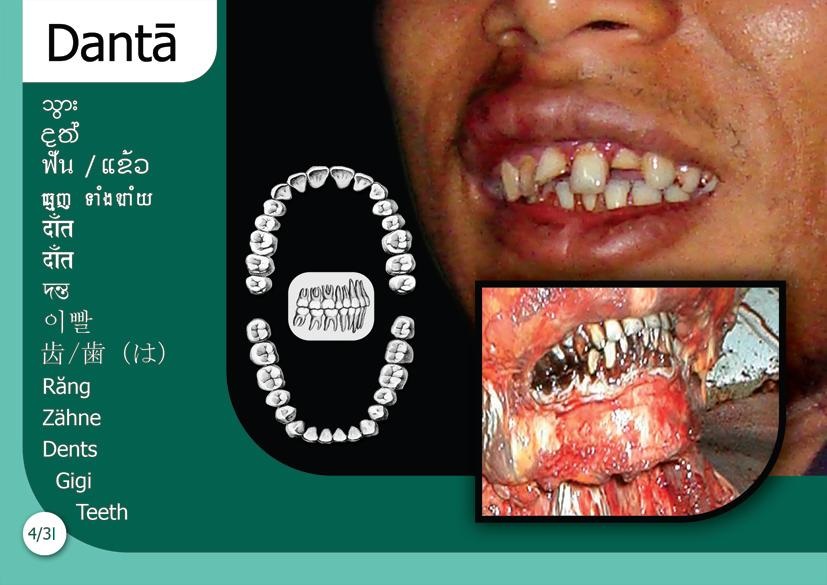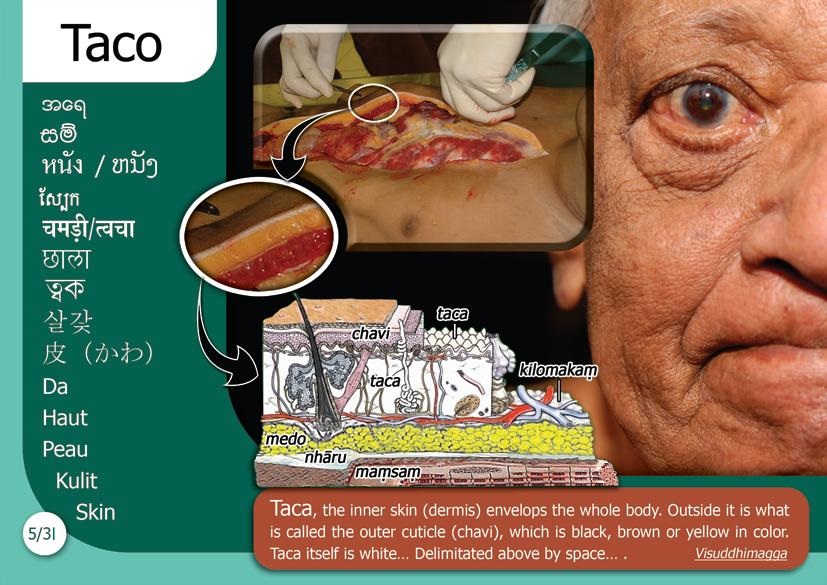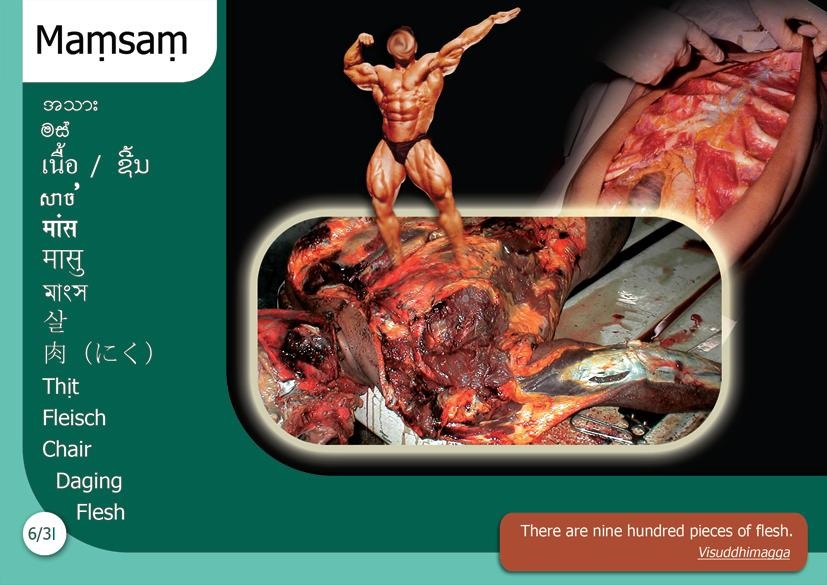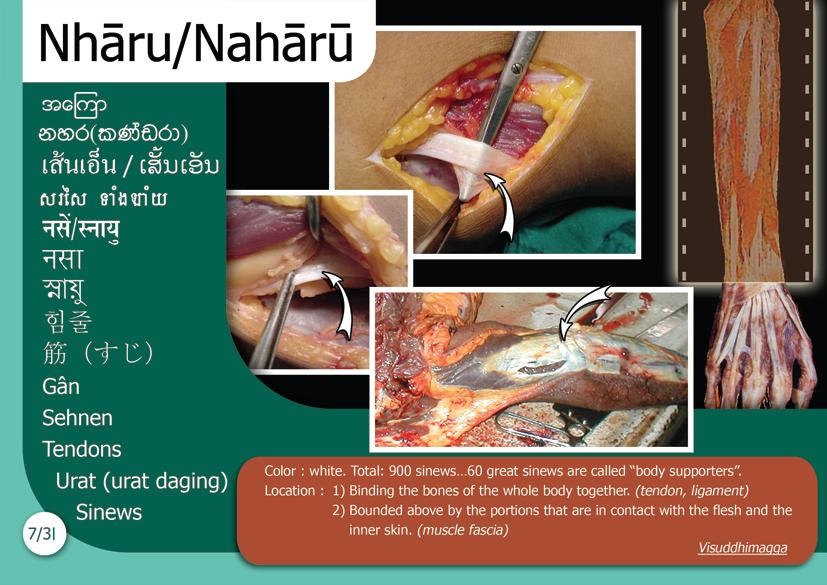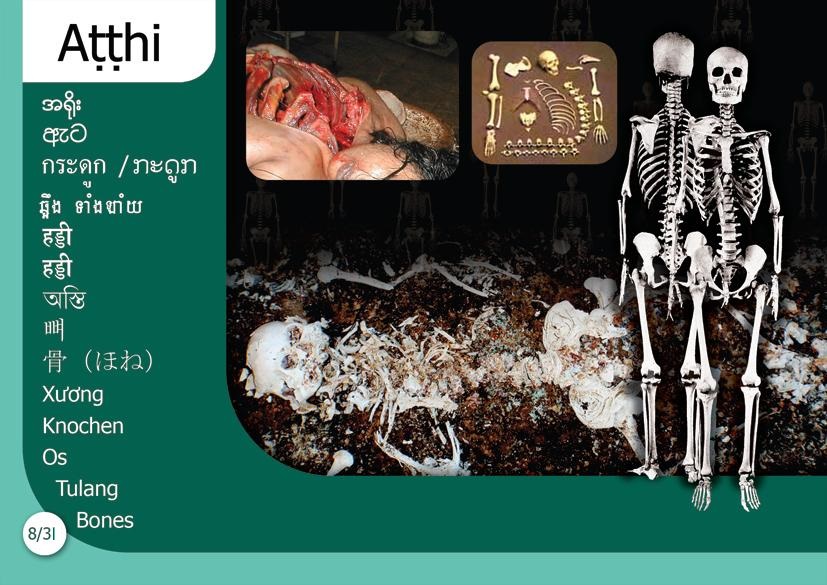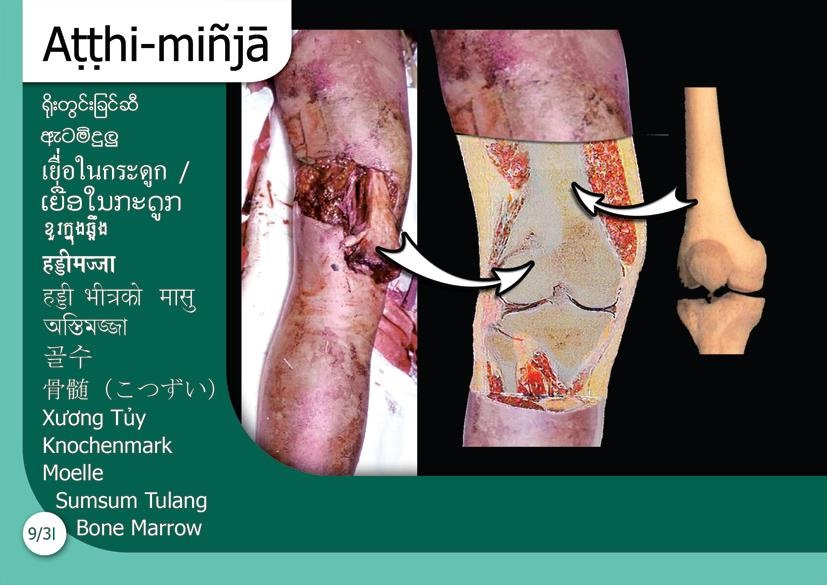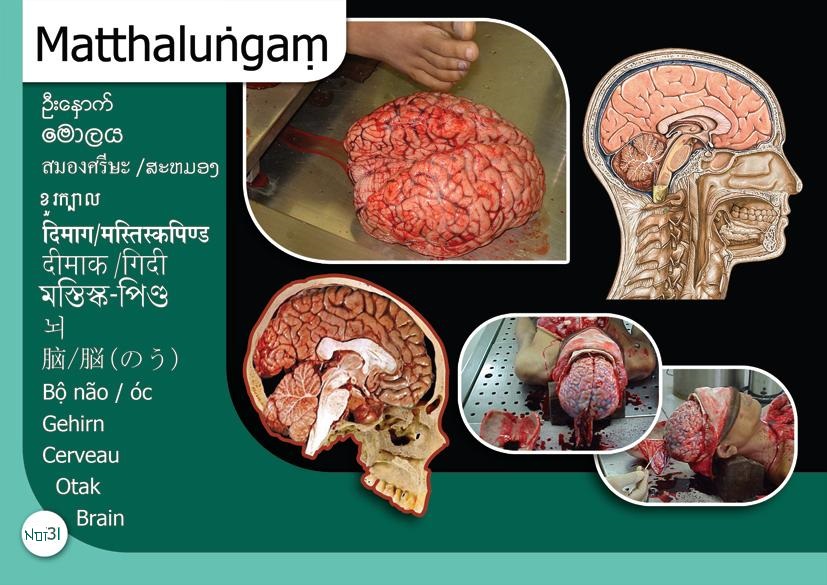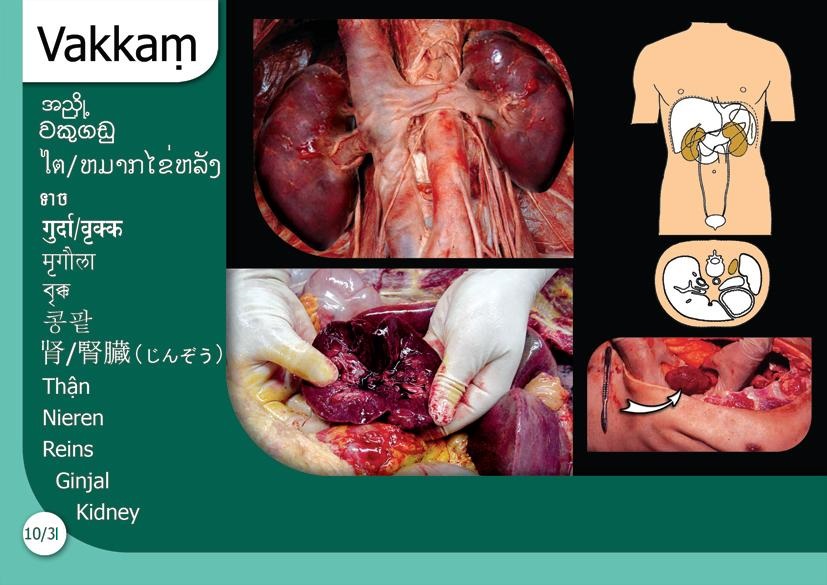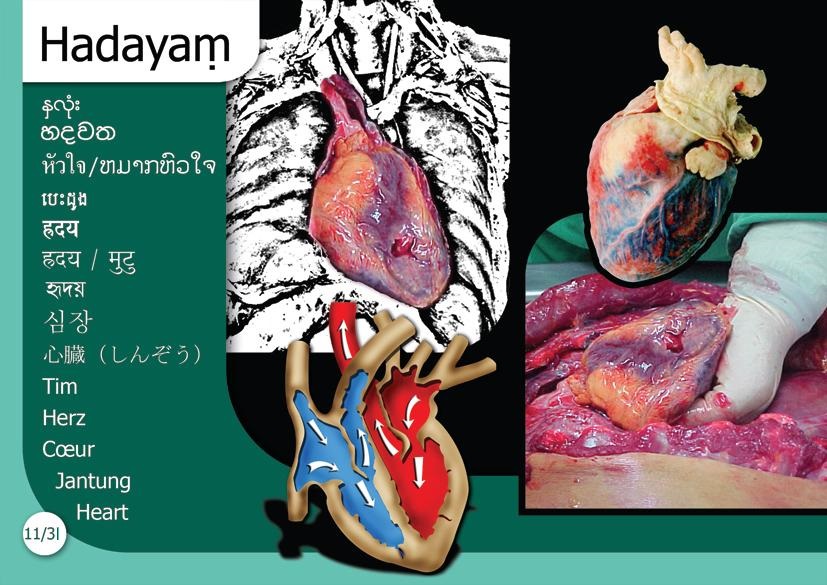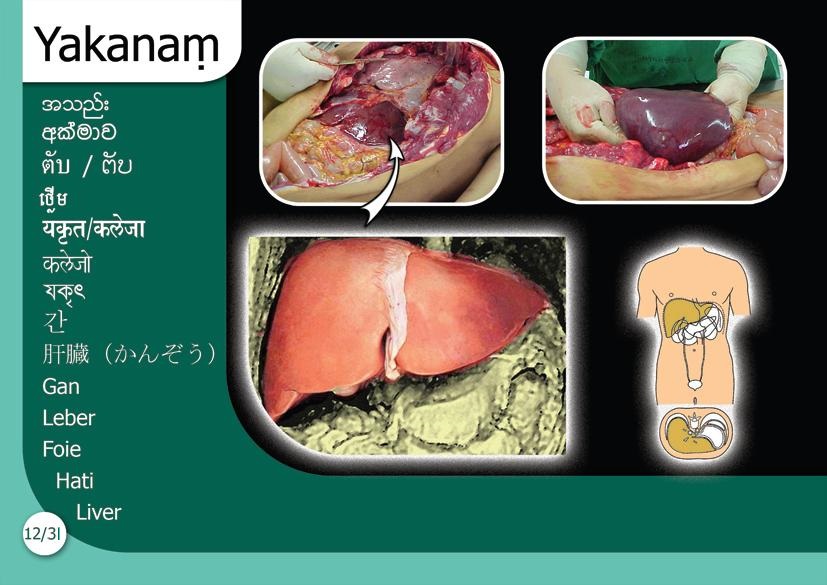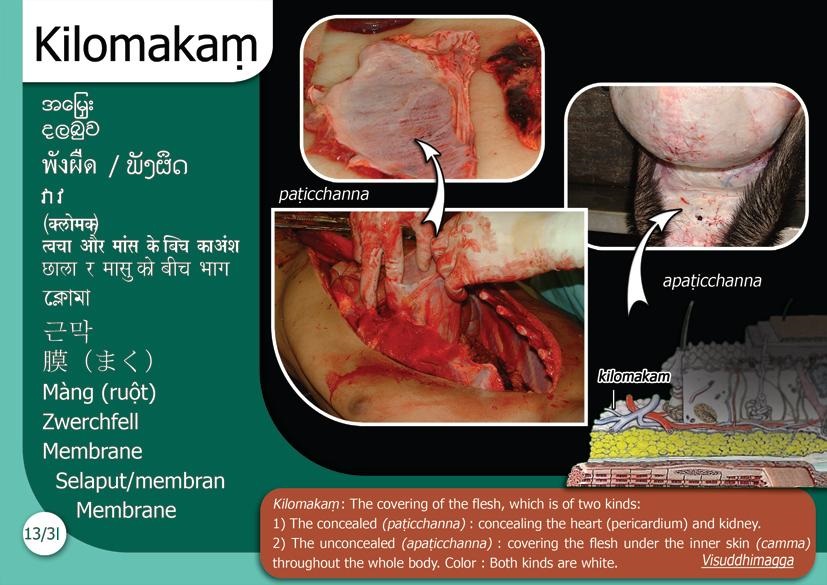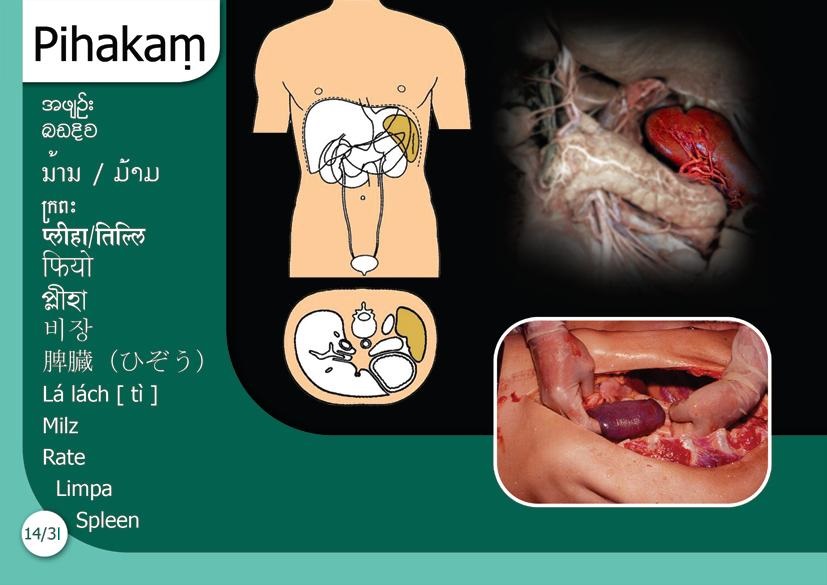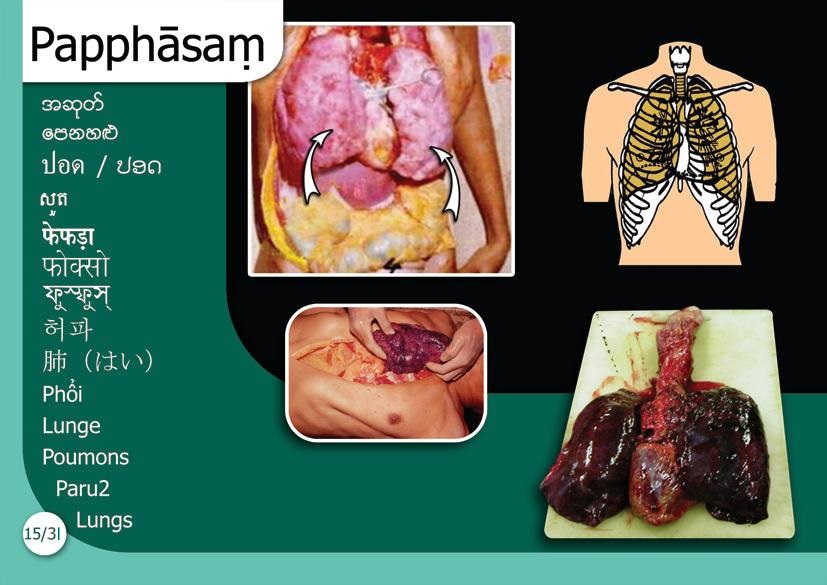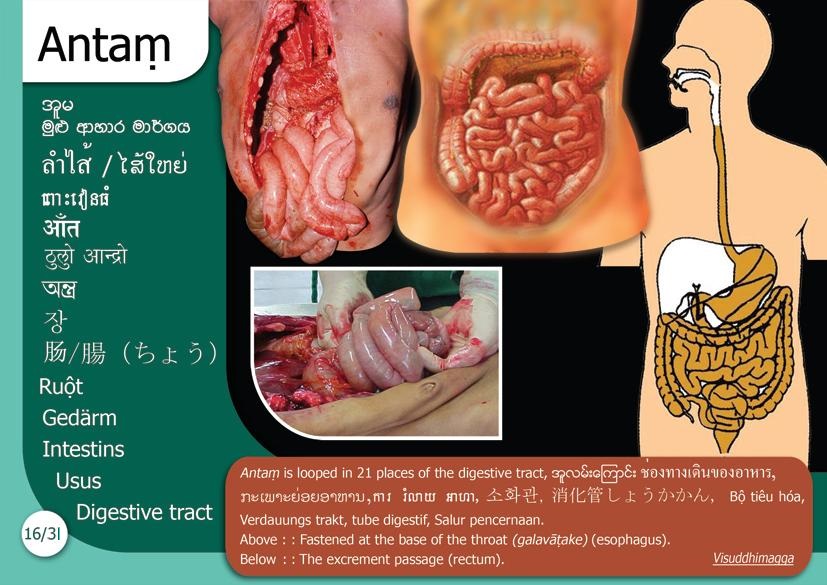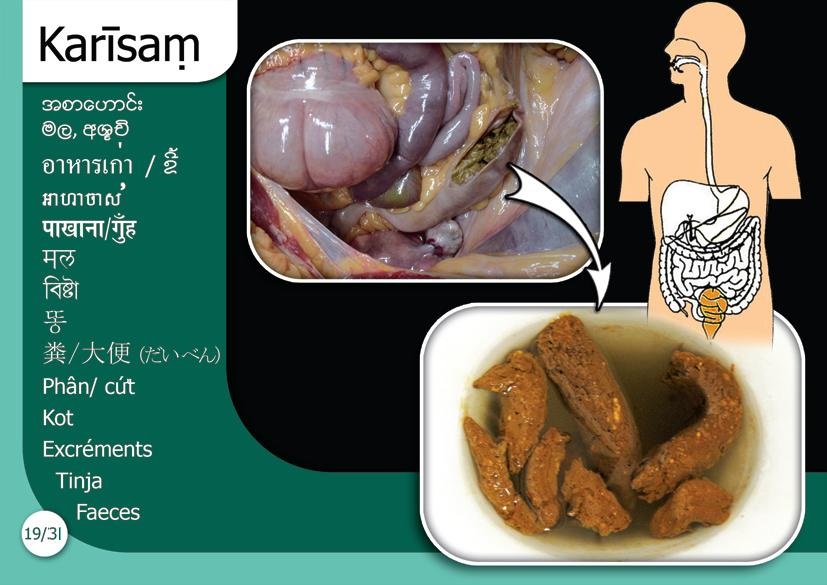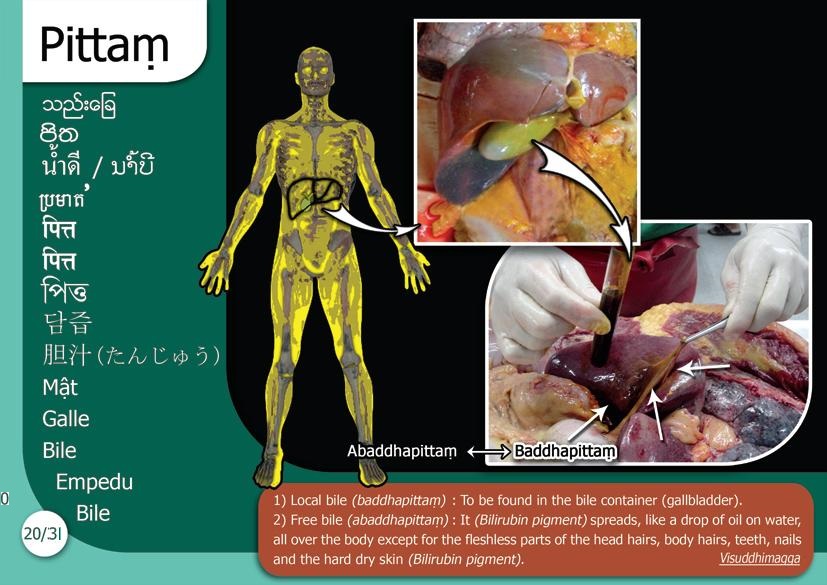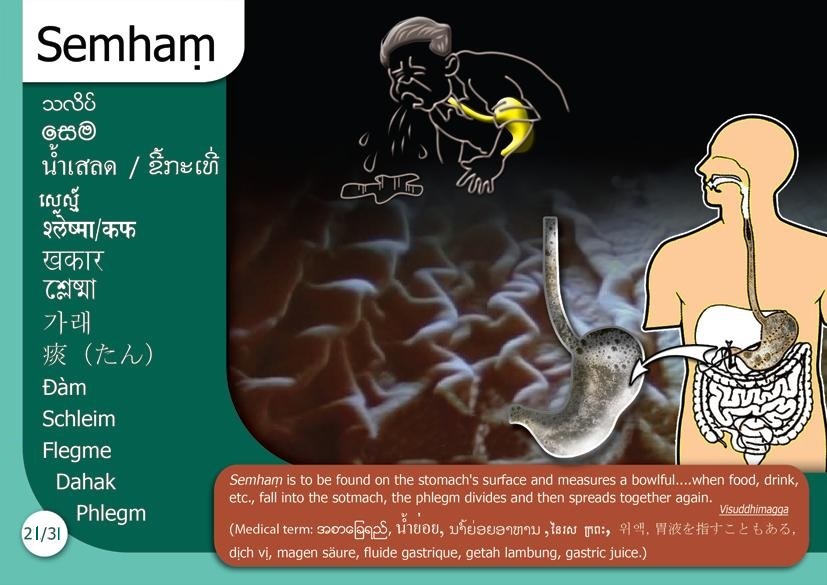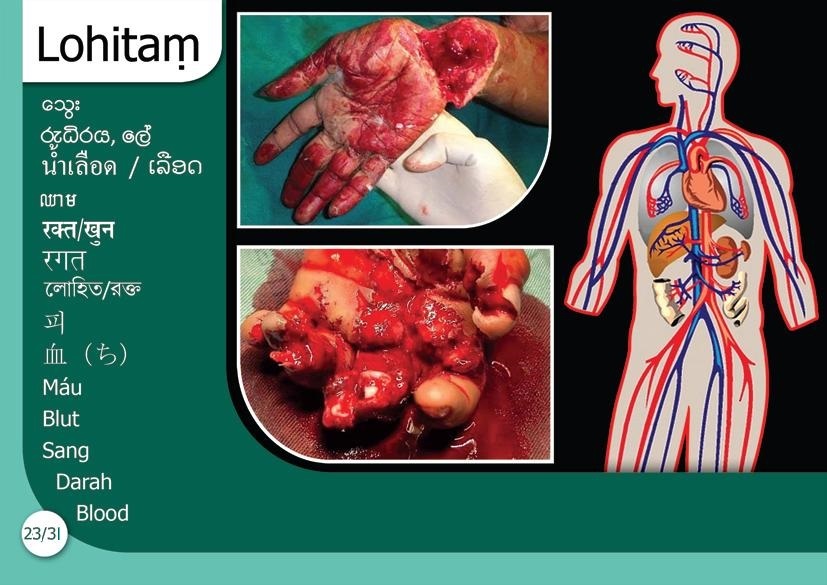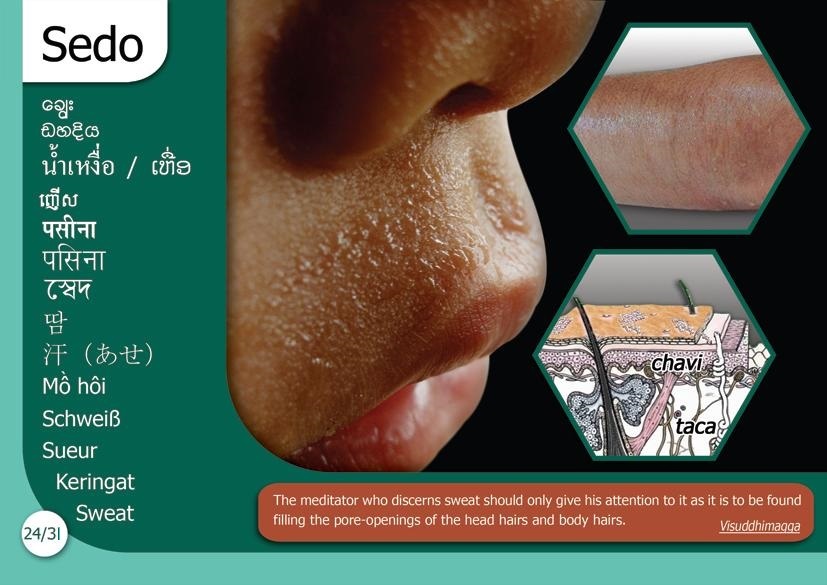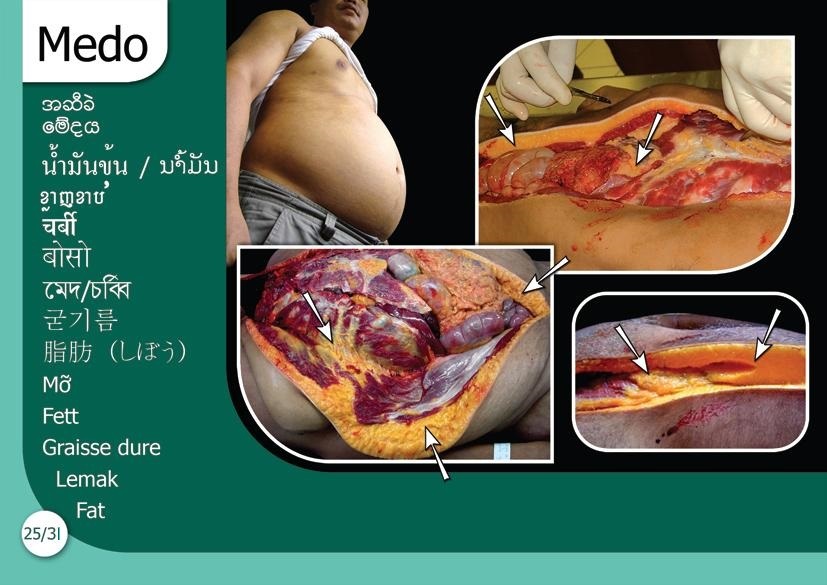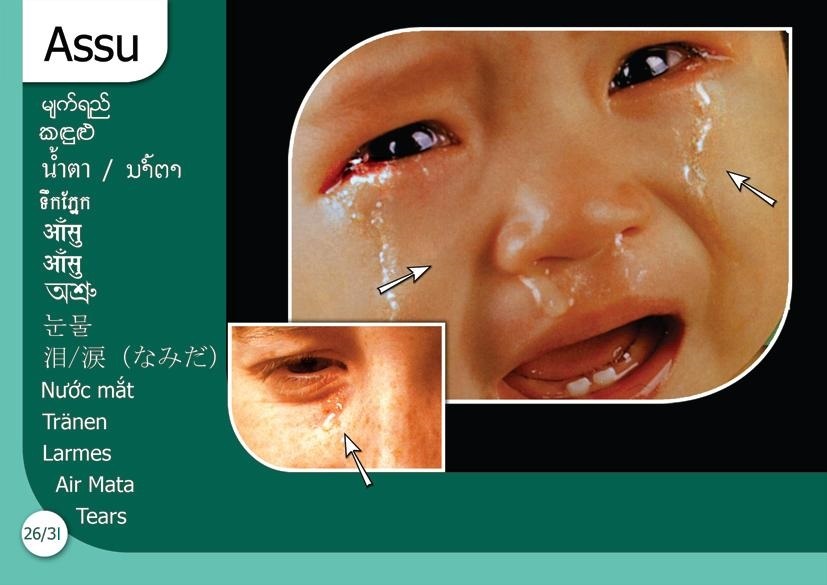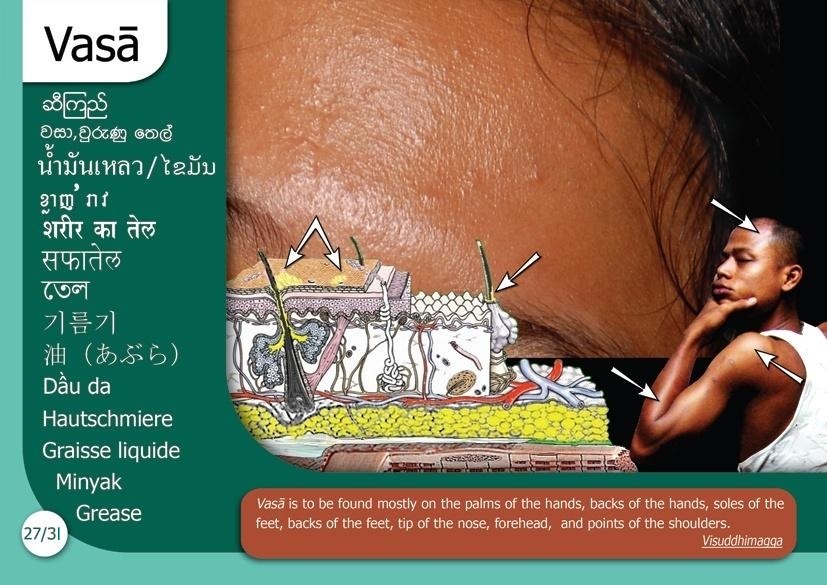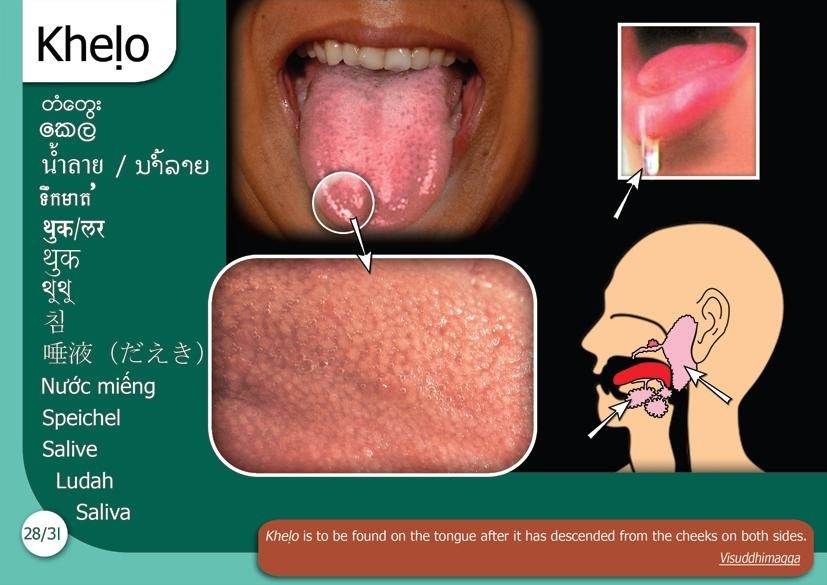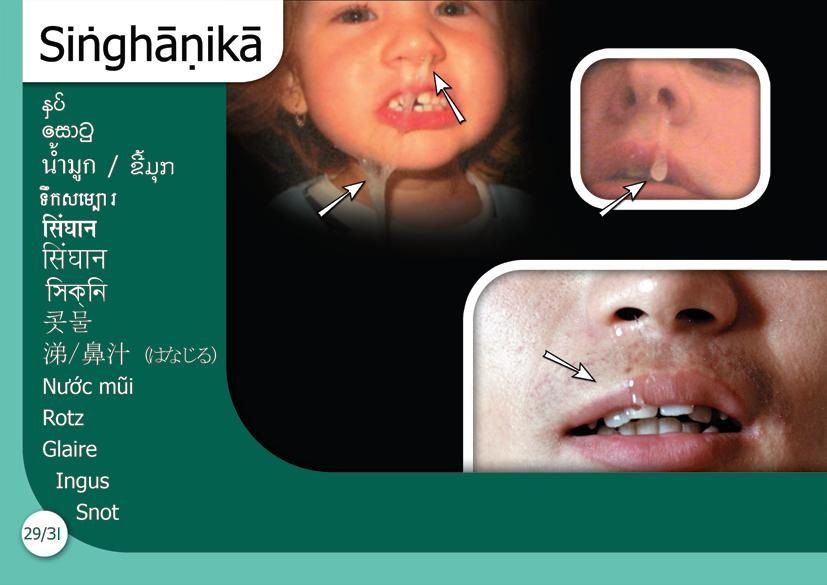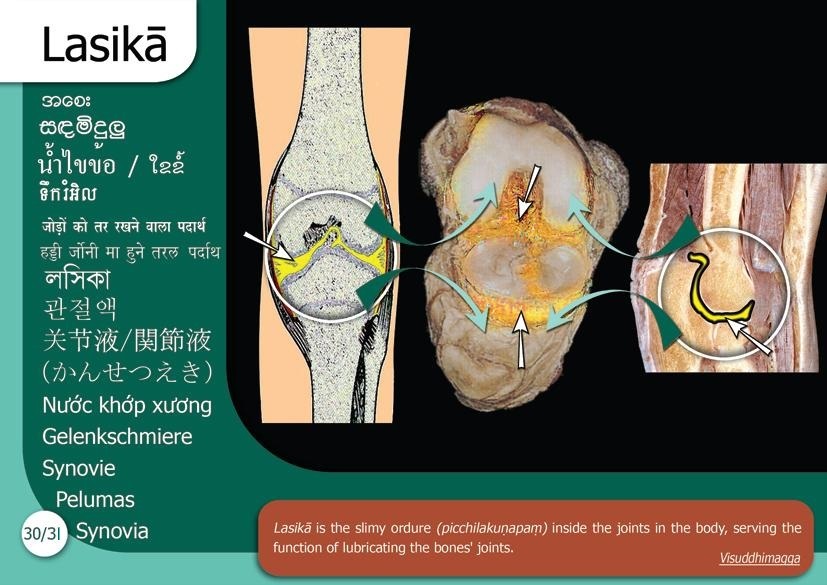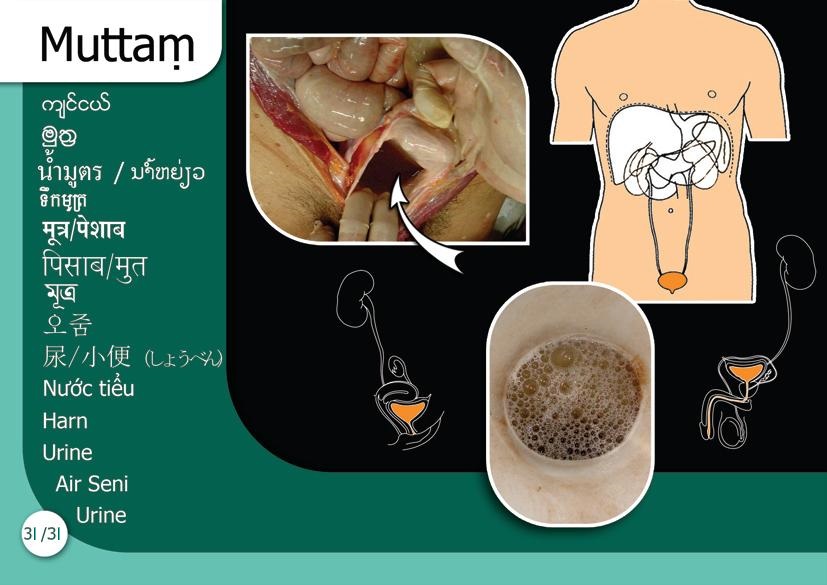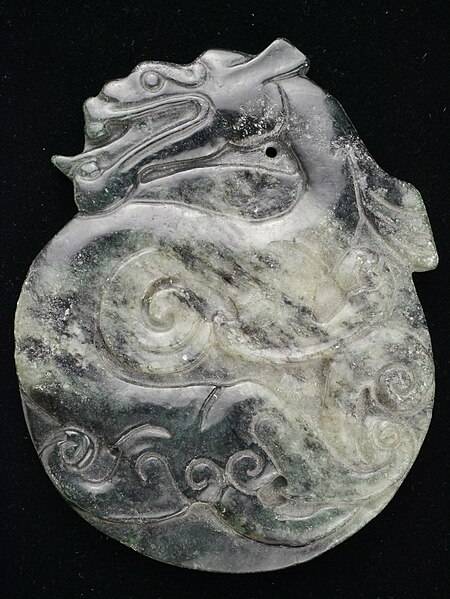31asb: where's the brain? 💩🧠
In KN Snp 1.11, the brain appears as an addition after the traditional group of 31.
In KN Khp 3, it follows the Vism. order, where it groups it in the end of the "earth element" group, right after feces.
KN Khp, 3. dvattiṃsākāro (KN 1.3), para. 5 ⇒
antaṃ antaguṇaṃ udariyaṃ karīsaṃ (feces) matthaluṅgaṃ, (brain)
What's the meaning of the phrase 'Shit for brains'?
https://www.phrases.org.uk/meanings/317900.htmlExtremely stupid.
What's the origin of the phrase 'Shit for brains'?
This term of abuse originated in the USA in the 1960s. The earliest record of it that I can find is David Maccuish's novel Do not go Gentle, 1960:"Larko's got shit for brains."
| matthaluṅgaṃ (4) | matthaluṅganti (2) |
| matthaluṅgañca (1) | matthaluṅgassa (1) |
DN
MN
SN
AN
KN
KN Khp, 3. dvattiṃsākāro (KN 1.3), para. 5 ⇒
antaṃ antaguṇaṃ udariyaṃ karīsaṃ matthaluṅgaṃ,
antaṃ antaguṇaṃ udariyaṃ karīsaṃ matthaluṅgaṃ,
KN Sn, 1. uragavaggo, 11. vijayasuttaṃ (KN 5.11), para. 20 ⇒
athassa susiraṃ sīsaṃ, matthaluṅgassa pūritaṃ.
athassa susiraṃ sīsaṃ, matthaluṅgassa pūritaṃ.
KN Paṭis, 1. mahāvaggo, 1. ñāṇakathā, 1. sutamayañāṇaniddeso, para. 25 ⇒
kesā abhiññeyyā; lomā abhiññeyyā; nakhā abhiññeyyā; dantā abhiññeyyā; taco abhiññeyyo, maṃsaṃ abhiññeyyaṃ; nhārū abhiññeyyā; aṭṭhī abhiññeyyā; aṭṭhimiñjā abhiññeyyā; vakkaṃ abhiññeyyaṃ; hadayaṃ abhiññeyyaṃ; yakanaṃ abhiññeyyaṃ; kilomakaṃ abhiññeyyaṃ; pihakaṃ abhiññeyyaṃ; papphāsaṃ abhiññeyyaṃ; antaṃ abhiññeyyaṃ antaguṇaṃ abhiññeyyaṃ; udariyaṃ abhiññeyyaṃ; karīsaṃ abhiññeyyaṃ; pittaṃ abhiññeyyaṃ; semhaṃ abhiññeyyaṃ; pubbo abhiññeyyo; lohitaṃ abhiññeyyaṃ; sedo abhiññeyyo; medo abhiññeyyo; assu abhiññeyyaṃ; vasā abhiññeyyā; kheḷo abhiññeyyo; siṅghāṇikā abhiññeyyā; lasikā abhiññeyyā; muttaṃ abhiññeyyaṃ; matthaluṅgaṃ abhiññeyyaṃ.
kesā abhiññeyyā; lomā abhiññeyyā; nakhā abhiññeyyā; dantā abhiññeyyā; taco abhiññeyyo, maṃsaṃ abhiññeyyaṃ; nhārū abhiññeyyā; aṭṭhī abhiññeyyā; aṭṭhimiñjā abhiññeyyā; vakkaṃ abhiññeyyaṃ; hadayaṃ abhiññeyyaṃ; yakanaṃ abhiññeyyaṃ; kilomakaṃ abhiññeyyaṃ; pihakaṃ abhiññeyyaṃ; papphāsaṃ abhiññeyyaṃ; antaṃ abhiññeyyaṃ antaguṇaṃ abhiññeyyaṃ; udariyaṃ abhiññeyyaṃ; karīsaṃ abhiññeyyaṃ; pittaṃ abhiññeyyaṃ; semhaṃ abhiññeyyaṃ; pubbo abhiññeyyo; lohitaṃ abhiññeyyaṃ; sedo abhiññeyyo; medo abhiññeyyo; assu abhiññeyyaṃ; vasā abhiññeyyā; kheḷo abhiññeyyo; siṅghāṇikā abhiññeyyā; lasikā abhiññeyyā; muttaṃ abhiññeyyaṃ; matthaluṅgaṃ abhiññeyyaṃ.
KN Paṭis, 1. mahāvaggo, 2. diṭṭhikathā, , para. 6 ⇒
kesaṃ etaṃ mama . pe . lomaṃ etaṃ mama. nakhaṃ etaṃ mama. dantaṃ etaṃ mama. tacaṃ etaṃ mama. maṃsaṃ etaṃ mama. nhāruṃ etaṃ mama. aṭṭhiṃ etaṃ mama. aṭṭhimiñjaṃ etaṃ mama. vakkaṃ etaṃ mama. hadayaṃ etaṃ mama. yakanaṃ etaṃ mama. kilomakaṃ etaṃ mama. pihakaṃ etaṃ mama. papphāsaṃ etaṃ mama. antaṃ etaṃ mama. antaguṇaṃ etaṃ mama. udariyaṃ etaṃ mama. karīsaṃ etaṃ mama. pittaṃ etaṃ mama. semhaṃ etaṃ mama. pubbaṃ etaṃ mama . lohitaṃ etaṃ mama. sedaṃ etaṃ mama. medaṃ etaṃ mama. assuṃ etaṃ mama. vasaṃ etaṃ mama . kheḷaṃ etaṃ mama. siṅghāṇikaṃ etaṃ mama. lasikaṃ etaṃ mama. muttaṃ etaṃ mama. matthaluṅgaṃ etaṃ mama, esohamasmi, eso me attāti — abhinivesaparāmāso diṭṭhi.
kesaṃ etaṃ mama . pe . lomaṃ etaṃ mama. nakhaṃ etaṃ mama. dantaṃ etaṃ mama. tacaṃ etaṃ mama. maṃsaṃ etaṃ mama. nhāruṃ etaṃ mama. aṭṭhiṃ etaṃ mama. aṭṭhimiñjaṃ etaṃ mama. vakkaṃ etaṃ mama. hadayaṃ etaṃ mama. yakanaṃ etaṃ mama. kilomakaṃ etaṃ mama. pihakaṃ etaṃ mama. papphāsaṃ etaṃ mama. antaṃ etaṃ mama. antaguṇaṃ etaṃ mama. udariyaṃ etaṃ mama. karīsaṃ etaṃ mama. pittaṃ etaṃ mama. semhaṃ etaṃ mama. pubbaṃ etaṃ mama . lohitaṃ etaṃ mama. sedaṃ etaṃ mama. medaṃ etaṃ mama. assuṃ etaṃ mama. vasaṃ etaṃ mama . kheḷaṃ etaṃ mama. siṅghāṇikaṃ etaṃ mama. lasikaṃ etaṃ mama. muttaṃ etaṃ mama. matthaluṅgaṃ etaṃ mama, esohamasmi, eso me attāti — abhinivesaparāmāso diṭṭhi.
KN Mil, 2-3. milindapañho, 1. mahāvaggo, 1. paññattipañho, para. 2 ⇒
atha kho milindo rājā evamāha “suṇantu me bhonto pañcasatā yonakā asītisahassā ca bhikkhū, ayaṃ nāgaseno evamāha ‘na hettha puggalo upalabbhatī’ti, kallaṃ nu kho tadabhinanditun”ti. atha kho milindo rājā āyasmantaṃ nāgasenaṃ etadavoca “sace, bhante nāgasena, puggalo nūpalabbhati, ko carahi tumhākaṃ cīvarapiṇḍapātasenāsanagilānappaccayabhesajjaparikkhāraṃ deti, ko taṃ paribhuñjati, ko sīlaṃ rakkhati, ko bhāvanamanuyuñjati, ko maggaphalanibbānāni sacchikaroti, ko pāṇaṃ hanati, ko adinnaṃ ādiyati, ko kāmesumicchācāraṃ carati, ko musā bhaṇati, ko majjaṃ pivati, ko pañcānantariyakammaṃ karoti, tasmā natthi kusalaṃ, natthi akusalaṃ, natthi kusalākusalānaṃ kammānaṃ kattā vā kāretā vā, natthi sukatadukkaṭānaṃ kammānaṃ phalaṃ vipāko, sace, bhante nāgasena, yo tumhe māreti, natthi tassāpi pāṇātipāto, tumhākampi, bhante nāgasena, natthi ācariyo, natthi upajjhāyo, natthi upasampadā. ‘nāgasenoti maṃ, mahārāja, sabrahmacārī samudācarantī’ti yaṃ vadesi, ‘katamo ettha nāgaseno ? kinnu kho, bhante, kesā nāgaseno”ti? “na hi mahārājā”ti. “lomā nāgaseno”ti? “na hi mahārājā”ti. “nakhā . pe . dantā . pe . taco . pe . maṃsaṃ . pe . nhāru . pe . aṭṭhi . pe . aṭṭhimiñjaṃ . pe . vakkaṃ . pe . hadayaṃ . pe . yakanaṃ . pe . kilomakaṃ . pe . pihakaṃ . pe . papphāsaṃ . pe . antaṃ . pe . antaguṇaṃ . pe . udariyaṃ . pe . karīsaṃ . pe . pittaṃ . pe . semhaṃ . pe . pubbo . pe . lohitaṃ . pe . sedo . pe . medo . pe . assu . pe . vasā . pe . kheḷo . pe . siṅghāṇikā . pe . lasikā . pe . muttaṃ . pe . matthake matthaluṅgaṃ nāgaseno”ti? “na himahārājā”ti. “kiṃ nu kho, bhante, rūpaṃ nāgaseno”ti? “nahi mahārājā”ti. “vedanā nāgaseno”ti?“na hi mahārājā”ti. “saññā nāgaseno”ti? “na hi mahārājā”ti. “saṅkhārā nāgaseno”ti? “na hi mahārājā”ti. “viññāṇaṃ nāgaseno”ti? “na hi mahārājā”ti. “kiṃ pana, bhante, rūpavedanāsaññāsaṅkhāraviññāṇaṃ nāgaseno”ti? “na hi mahārājā”ti. “kiṃ pana, bhante, aññatra rūpavedanāsaññāsaṅkhāraviññāṇaṃ nāgaseno”ti? “na hi mahārājā”ti. “tamahaṃ bhante, pucchanto pucchanto na passāmi nāgasenaṃ. nāgasenasaddo yeva nu kho, bhante, nāgaseno”ti? “na hi mahārājā”ti. “ko panettha nāgaseno, alikaṃ tvaṃ, bhante, bhāsasi musāvādaṃ, natthi nāgaseno”ti.
atha kho milindo rājā evamāha “suṇantu me bhonto pañcasatā yonakā asītisahassā ca bhikkhū, ayaṃ nāgaseno evamāha ‘na hettha puggalo upalabbhatī’ti, kallaṃ nu kho tadabhinanditun”ti. atha kho milindo rājā āyasmantaṃ nāgasenaṃ etadavoca “sace, bhante nāgasena, puggalo nūpalabbhati, ko carahi tumhākaṃ cīvarapiṇḍapātasenāsanagilānappaccayabhesajjaparikkhāraṃ deti, ko taṃ paribhuñjati, ko sīlaṃ rakkhati, ko bhāvanamanuyuñjati, ko maggaphalanibbānāni sacchikaroti, ko pāṇaṃ hanati, ko adinnaṃ ādiyati, ko kāmesumicchācāraṃ carati, ko musā bhaṇati, ko majjaṃ pivati, ko pañcānantariyakammaṃ karoti, tasmā natthi kusalaṃ, natthi akusalaṃ, natthi kusalākusalānaṃ kammānaṃ kattā vā kāretā vā, natthi sukatadukkaṭānaṃ kammānaṃ phalaṃ vipāko, sace, bhante nāgasena, yo tumhe māreti, natthi tassāpi pāṇātipāto, tumhākampi, bhante nāgasena, natthi ācariyo, natthi upajjhāyo, natthi upasampadā. ‘nāgasenoti maṃ, mahārāja, sabrahmacārī samudācarantī’ti yaṃ vadesi, ‘katamo ettha nāgaseno ? kinnu kho, bhante, kesā nāgaseno”ti? “na hi mahārājā”ti. “lomā nāgaseno”ti? “na hi mahārājā”ti. “nakhā . pe . dantā . pe . taco . pe . maṃsaṃ . pe . nhāru . pe . aṭṭhi . pe . aṭṭhimiñjaṃ . pe . vakkaṃ . pe . hadayaṃ . pe . yakanaṃ . pe . kilomakaṃ . pe . pihakaṃ . pe . papphāsaṃ . pe . antaṃ . pe . antaguṇaṃ . pe . udariyaṃ . pe . karīsaṃ . pe . pittaṃ . pe . semhaṃ . pe . pubbo . pe . lohitaṃ . pe . sedo . pe . medo . pe . assu . pe . vasā . pe . kheḷo . pe . siṅghāṇikā . pe . lasikā . pe . muttaṃ . pe . matthake matthaluṅgaṃ nāgaseno”ti? “na himahārājā”ti. “kiṃ nu kho, bhante, rūpaṃ nāgaseno”ti? “nahi mahārājā”ti. “vedanā nāgaseno”ti?“na hi mahārājā”ti. “saññā nāgaseno”ti? “na hi mahārājā”ti. “saṅkhārā nāgaseno”ti? “na hi mahārājā”ti. “viññāṇaṃ nāgaseno”ti? “na hi mahārājā”ti. “kiṃ pana, bhante, rūpavedanāsaññāsaṅkhāraviññāṇaṃ nāgaseno”ti? “na hi mahārājā”ti. “kiṃ pana, bhante, aññatra rūpavedanāsaññāsaṅkhāraviññāṇaṃ nāgaseno”ti? “na hi mahārājā”ti. “tamahaṃ bhante, pucchanto pucchanto na passāmi nāgasenaṃ. nāgasenasaddo yeva nu kho, bhante, nāgaseno”ti? “na hi mahārājā”ti. “ko panettha nāgaseno, alikaṃ tvaṃ, bhante, bhāsasi musāvādaṃ, natthi nāgaseno”ti.
KN Mil, 2-3. milindapañho, 1. mahāvaggo, 1. paññattipañho, para. 5 ⇒
“sādhu kho, tvaṃ mahārāja, rathaṃ jānāsi, evameva kho, mahārāja, mayhampi kese ca paṭicca lome ca paṭicca . pe . matthake matthaluṅgañca paṭicca rūpañca paṭicca vedanañca paṭicca saññañca paṭicca saṅkhāre ca paṭicca viññāṇañca paṭicca ‘nāgaseno’ti saṅkhā samaññā paññatti vohāro nāmamattaṃ pavattati, paramatthato panettha puggalo nūpalabbhati. bhāsitampetaṃ, mahārāja, vajirāya bhikkhuniyā bhagavato sammukhā —
“sādhu kho, tvaṃ mahārāja, rathaṃ jānāsi, evameva kho, mahārāja, mayhampi kese ca paṭicca lome ca paṭicca . pe . matthake matthaluṅgañca paṭicca rūpañca paṭicca vedanañca paṭicca saññañca paṭicca saṅkhāre ca paṭicca viññāṇañca paṭicca ‘nāgaseno’ti saṅkhā samaññā paññatti vohāro nāmamattaṃ pavattati, paramatthato panettha puggalo nūpalabbhati. bhāsitampetaṃ, mahārāja, vajirāya bhikkhuniyā bhagavato sammukhā —
KN Nett, 4. paṭiniddesavāro, 14. adhiṭṭhānahāravibhaṅgo, para. 11 ⇒
katamehi vīsatiyā ākārehi pathavīdhātuṃ vitthārena pariggaṇhāti? atthi imasmiṃ kāye kesā lomā nakhā dantā taco, maṃsaṃ nhāru aṭṭhi aṭṭhimiñjaṃ vakkaṃ, hadayaṃ yakanaṃ kilomakaṃ pihakaṃ papphāsaṃ, antaṃ antaguṇaṃ udariyaṃ karīsaṃ matthake matthaluṅganti imehi vīsatiyā ākārehi pathavīdhātuṃ vitthārena pariggaṇhāti.
katamehi vīsatiyā ākārehi pathavīdhātuṃ vitthārena pariggaṇhāti? atthi imasmiṃ kāye kesā lomā nakhā dantā taco, maṃsaṃ nhāru aṭṭhi aṭṭhimiñjaṃ vakkaṃ, hadayaṃ yakanaṃ kilomakaṃ pihakaṃ papphāsaṃ, antaṃ antaguṇaṃ udariyaṃ karīsaṃ matthake matthaluṅganti imehi vīsatiyā ākārehi pathavīdhātuṃ vitthārena pariggaṇhāti.
KN Nett, 4. paṭiniddesavāro, 14. adhiṭṭhānahāravibhaṅgo, para. 22 ⇒
“kāyo”ti ekattatā. tattha katamo kāyo? nāmakāyo rūpakāyo ca. tattha katamo rūpakāyo? kesā lomā nakhā dantā taco maṃsaṃ nhāru aṭṭhi aṭṭhimiñjaṃ vakkaṃ hadayaṃ yakanaṃ kilomakaṃ pihakaṃ papphāsaṃ antaṃ antaguṇaṃ udariyaṃ karīsaṃ pittaṃ semhaṃ pubbo lohitaṃ sedo medo assu vasā kheḷo siṅghāṇikā lasikā muttaṃ matthaluṅganti — ayaṃ rūpakāyo. nāmakāyo nāma vedanā saññā cetanā cittaṃ phasso manasikāroti — ayaṃ nāmakāyoti. ayaṃ vemattatā.
“kāyo”ti ekattatā. tattha katamo kāyo? nāmakāyo rūpakāyo ca. tattha katamo rūpakāyo? kesā lomā nakhā dantā taco maṃsaṃ nhāru aṭṭhi aṭṭhimiñjaṃ vakkaṃ hadayaṃ yakanaṃ kilomakaṃ pihakaṃ papphāsaṃ antaṃ antaguṇaṃ udariyaṃ karīsaṃ pittaṃ semhaṃ pubbo lohitaṃ sedo medo assu vasā kheḷo siṅghāṇikā lasikā muttaṃ matthaluṅganti — ayaṃ rūpakāyo. nāmakāyo nāma vedanā saññā cetanā cittaṃ phasso manasikāroti — ayaṃ nāmakāyoti. ayaṃ vemattatā.



